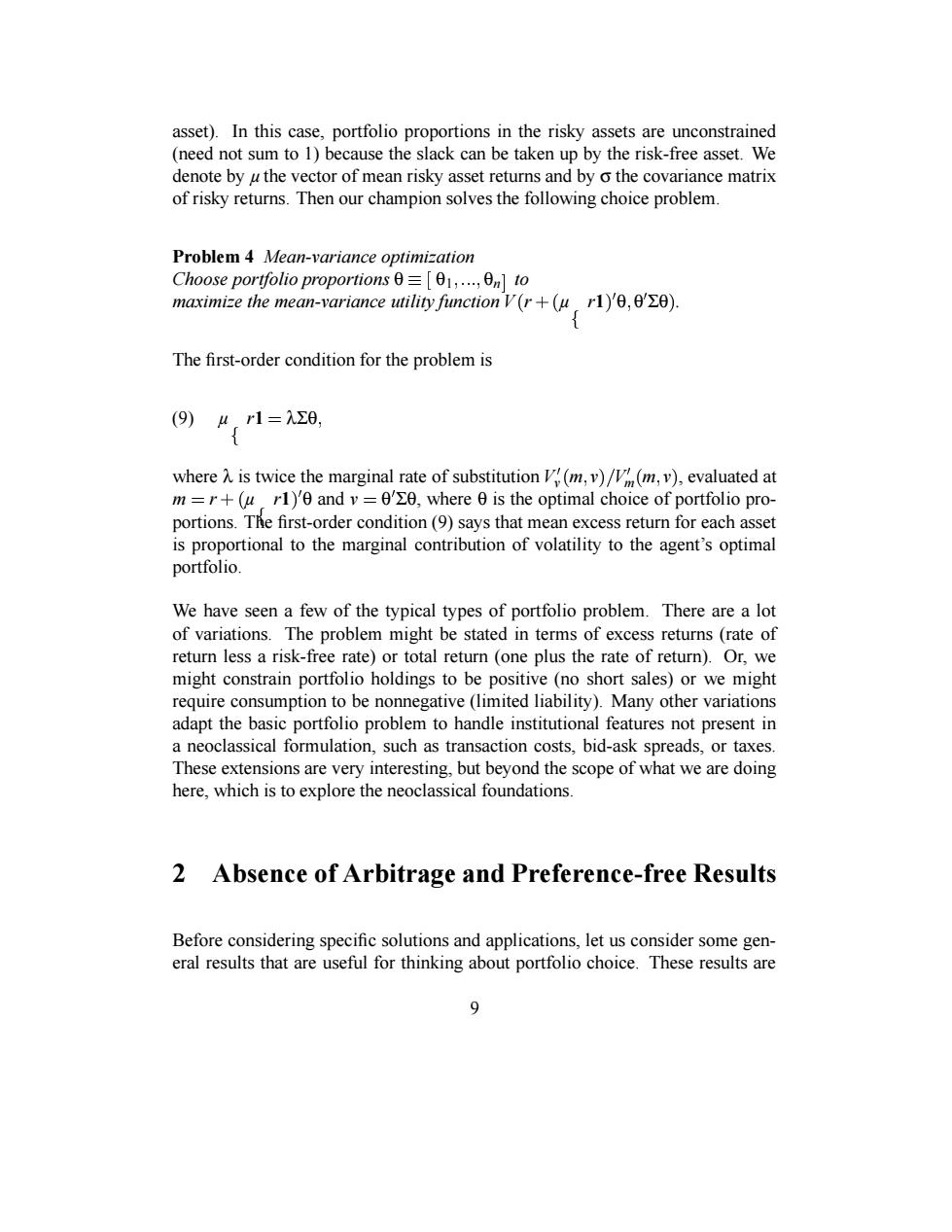正在加载图片...

asset).In this case,portfolio proportions in the risky assets are unconstrained (need not sum to 1)because the slack can be taken up by the risk-free asset.We denote by u the vector of mean risky asset returns and by o the covariance matrix of risky returns.Then our champion solves the following choice problem. Problem 4 Mean-variance optimization Choose portfolio proportions0=[θ1,,6nlto naximize the mean--variance utility function V(c+(u.rl)'0,θ'∑Σ0) The first-order condition for the problem is (9)4,r1=入∑0, whereis twice the marginal rate of substitution (m,v)(m,v),evaluated at m=r+(u r1)'0 and v=0'0,where 0 is the optimal choice of portfolio pro- portions.The first-order condition(9)says that mean excess return for each asset is proportional to the marginal contribution of volatility to the agent's optimal portfolio. We have seen a few of the typical types of portfolio problem.There are a lot of variations.The problem might be stated in terms of excess returns(rate of return less a risk-free rate)or total return (one plus the rate of return).Or,we might constrain portfolio holdings to be positive (no short sales)or we might require consumption to be nonnegative (limited liability).Many other variations adapt the basic portfolio problem to handle institutional features not present in a neoclassical formulation,such as transaction costs,bid-ask spreads,or taxes. These extensions are very interesting,but beyond the scope of what we are doing here,which is to explore the neoclassical foundations. 2 Absence of Arbitrage and Preference-free Results Before considering specific solutions and applications,let us consider some gen- eral results that are useful for thinking about portfolio choice.These results are 9asset). In this case, portfolio proportions in the risky assets are unconstrained (need not sum to 1) because the slack can be taken up by the risk-free asset. We denote by µ the vector of mean risky asset returns and by σ the covariance matrix of risky returns. Then our champion solves the following choice problem. Problem 4 Mean-variance optimization Choose portfolio proportions θ θ1 ✄ ☎✞☎✝☎✞✄ θn ✁ to maximize the mean-variance utility function V ✁ r ✄ ✁ µ r1 ✂ ✞ θ ✄ θ✞ Σθ✂ . The first-order condition for the problem is (9) µ r1 ✂ λΣθ ✄ where λ is twice the marginal rate of substitution V ✞ v ✁ m ✄ v ✂ Vm✞ ✁ m ✄ v ✂ , evaluated at m ✂ r ✄ ✁ µ r1 ✂ ✞ θ and v ✂ θ✞ Σθ, where θ is the optimal choice of portfolio proportions. The first-order condition (9) says that mean excess return for each asset is proportional to the marginal contribution of volatility to the agent’s optimal portfolio. We have seen a few of the typical types of portfolio problem. There are a lot of variations. The problem might be stated in terms of excess returns (rate of return less a risk-free rate) or total return (one plus the rate of return). Or, we might constrain portfolio holdings to be positive (no short sales) or we might require consumption to be nonnegative (limited liability). Many other variations adapt the basic portfolio problem to handle institutional features not present in a neoclassical formulation, such as transaction costs, bid-ask spreads, or taxes. These extensions are very interesting, but beyond the scope of what we are doing here, which is to explore the neoclassical foundations. 2 Absence of Arbitrage and Preference-free Results Before considering specific solutions and applications, let us consider some general results that are useful for thinking about portfolio choice. These results are 9